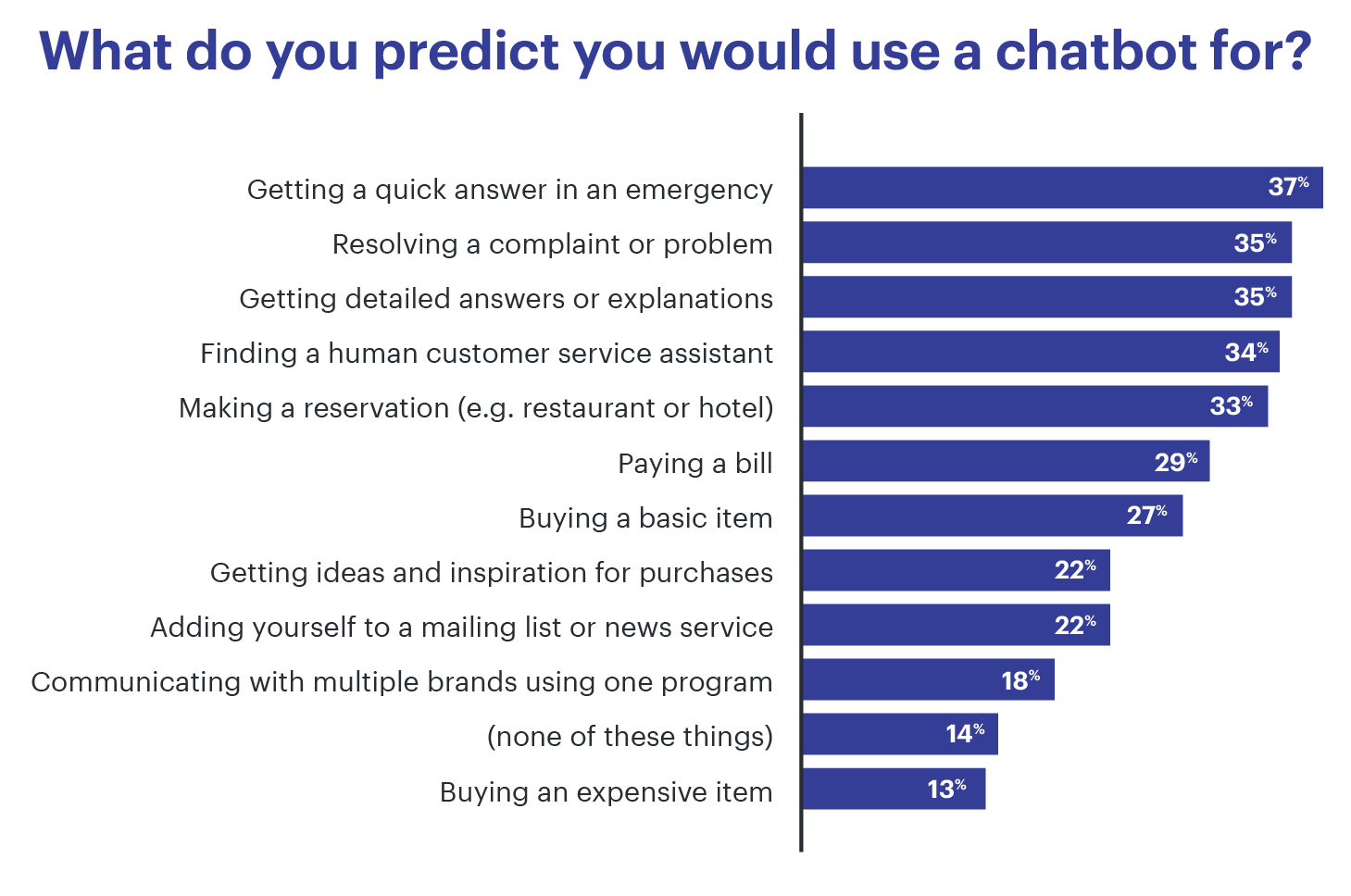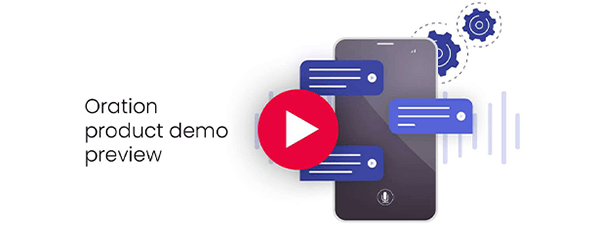It’s hard to believe there was a time when consumers were wary of chatbots. The concept of ‘conversing’ with an automated agent was a little too futuristic for some, a little scary for others. “I’d rather stay on hold and speak to a real person,” was a common refrain from some customers as they struggled to get their heads around the latest innovation to sweep contact centres.
Haven’t times changed? It only takes a quick scroll of recent studies to see that chatbots are not just accepted by today’s consumers but changing customer experience for the better.
- 69% of consumers were satisfied with their last interaction with a chatbot[1]
- 64% of consumers say the best feature of chatbots is their 24/7 availability[2]
- Chatbots are tipped to save businesses up to 2.5 billion hours of work this year[3]
- 88% of people had at least one conversation with a chatbot in 2022[4]
- The global chatbot market is tipped to reach $994 million in 2024[5].
The chatbot boom is also being fueled by artificial intelligence (AI), with 84% of companies believing AI chatbots will become important for communication between customers and businesses[6]. For organisations yet to embrace chatbots in the contact centre space, implementation is no longer a matter of if but when. The benefits speak for themselves, which leaves one vital question for executives and managers – what type of chatbot use case should we deploy?


Source: Complete Guide to Chatbots | Leadoo
Types of chatbots
There are different types of chatbots, each designed with a specific business purpose. Here are five of the most common:
1. Rule-based chatbots
These are the most basic types of chatbot. They follow a predefined set of rules and can only respond to specific commands or keywords. Think of them as interactive FAQs.
- Pros: simple to build, cost-effective.
- Cons: limited functionality, can't handle complex queries.
- Best for: answering simple questions, providing basic information.
2. AI-powered chatbots
These chatbots use artificial intelligence (AI) and natural language processing (NLP) to understand and respond to user queries in a more conversational manner. They can learn and improve over time.
- Pros: more flexible, can handle complex conversations.
- Cons: can be more expensive to develop.
- Best for: providing personalised customer service, lead generation.
3. Keyword recognition-based chatbots
These chatbots identify keywords in user input to trigger pre-programmed responses. They are more advanced than rule-based chatbots but less sophisticated than AI-powered ones.
- Pros: can handle a wider range of queries than rule-based chatbots.
- Cons: may not always understand the context of the conversation.
- Best for: guiding users through a process, providing specific information.
4. Machine learning chatbots
These chatbots use machine learning algorithms to learn from past interactions and improve their responses over time. They are a type of AI-powered chatbot.
- Pros: can adapt to different situations, provide personalised responses.
- Cons: require a large amount of data to train effectively.
- Best for: complex customer service interactions, personalised recommendations.
5. The hybrid model
This approach combines the best of both worlds by integrating rule-based systems with AI. This allows for a chatbot that can handle both simple and complex queries effectively.
- Pros: offers flexibility and scalability.
- Cons: can be more complex to implement.
- Best for: businesses with diverse needs and a large customer base.
What are the benefits of chatbots?
Increasing efficiencies and reducing costs are often cited as reasons to adopt chatbot technology but the benefits extend much further.
- 24/7 support: today’s customers not only expect support as soon as they want it but on the channel of their choice. Deploying chatbots allows businesses to provide consumers with the seamless, always-on connection they desire.
- Scalability: it is no secret customer requests are growing but an added factor is the rise in demand is unfolding when businesses are under increasing pressure to rein in costs. Chatbots address this concern by ensuring teams can help more customers without needing to hire more staff.
- Personalisation: a key benefit of chatbots is their role as the first point of contact for customers. Their ability to capture details such as name, issue and contact details before passing the customer on to an agent creates a golden opportunity for businesses to personalise the conversation.
When should you consider using a chatbot?
Chatbots are powerful tools, but they're not a magic solution for every business. Here's a breakdown of situations where a chatbot could be a game-changer:
High volume of repetitive enquiries
Are you constantly answering the same questions over and over? A chatbot can handle those repetitive queries, freeing up human agents to tackle more complex issues. Think FAQs, order tracking, basic account information – perfect for a bot!
24/7 availability is crucial
Your customers aren't sticking to a 9-to-5 schedule. A chatbot ensures your business is always ‘open’, providing instant support and information no matter the time or day. This boosts customer satisfaction and can even lead to increased sales.
Personalised customer experiences are key
Modern chatbots can do more than just answer questions. They can offer personalised recommendations, guide users through your website and even collect valuable data to help you understand your customers better.
Streamlining lead generation and qualification
Imagine a chatbot that pre-qualifies leads, gathers contact information and schedules appointments while you focus on closing deals. That's the power of a well-designed chatbot in your sales funnel.
Boosting team efficiency
Chatbots can act as a first line of defence, handling simple queries and escalating complex issues to human agents. This reduces your team's workload and allows them to focus on what they do best.
Gathering customer feedback
Chatbots can seamlessly integrate surveys and feedback forms into the conversation, providing valuable insights into customer satisfaction and areas for improvement.
Cost optimisation
While there's an initial investment, chatbots can significantly reduce customer service costs in the long run. They can handle a large volume of enquiries simultaneously, reducing the need for a large human support team.
What are Oration’s three Chatbot use cases?
Oration by Convai is a cost-effective and easy-to-install solution that combines the latest generation of speech recognition technology with its AI language interpreter to determine caller intent and fast-track calls to the best outcomes. Crucially, businesses have several use case options when investing in its chatbot features.
- Routing: a routing chatbot is designed to ensure customers reach the best destination for their enquiry as quickly as possible. Widely considered the most simple of use cases, it is highly effective as it reduces internal transfer rates by seamlessly routing contacts to the correct agents to help address their concerns. For example, if a consumer indicated they wanted to confirm their balance, the routing chatbot will automatically transfer them to an agent who could assist them.
- Referring (FAQ): the next use case on the chatbot hierarchy is the referring model, which has the capability to provide customers with access to the information they are seeking. This may come in the form of an FAQ or self-service function, with Oration’s natural language processing technology able to determine their intent. Using the banking example, the referring chatbot could say: “It looks like you’re seeking your balance. We have an online tool that can help you – would you like the link to the log-in page.”
- Automating: the most advanced use case is automating, which is also known as personalising. This function sees the chatbot able to address an enquiry on its own, pending identification of the customer via the back-end system. If they were seeking their bank balance, the chatbot is able to step them through the identification verification and deliver the amount without the need to route or refer the customer elsewhere.


Source: Top 37 Chatbot Applications & Use Cases in 2024 (aimultiple.com)
What is the best chatbot use case?
The first thing to know is that no AI chatbot is going to completely eliminate agent workloads. While some technology providers like to portray that possibility, the reality is adopting chatbots is all about easing workloads by blending technology with human agents.
While automating may seem like the most powerful of chatbot use cases, we strongly believe in working with clients to identify the option that is best for their needs. It is often more important for businesses to get quick wins than wait for the big jackpot, which is why we highlight that routing and referring can deliver benefits much faster at lower cost, even if those benefits are slightly reduced. The key is that we have conversations with clients about what they want to do with their chatbots and help them identify where the value lies.
Ultimately, our goal is to help unlock value quickly and we often find that is achieved by focusing on the two simpler use cases (routing and referring) and strategically targeting the use of automating in special circumstances. While the latter may seem like the answer to all your contact centre prayers, we know from experience that businesses that rush for the all-singing, all-dancing chatbot tend to end up regretting their decision. Rather than get oversold on the ability of a chatbot, there is a lot to be said for partnering with an expert who appreciates the need to mix simplicity with strategy.
Running a contact centre is hard enough without adding peak demand into the mix. Learn how technology can help ease the strain when confronted with a spike in activity.
References
1. The Future of Chatbots: 80+ Chatbot Statistics for 2024 (tidio.com)
2. 50+ Vital Chatbot Statistics for 2023 Every Marketer Should Know (outgrow.co)
3. Chatbots to Deliver $11bn in Annual Cost Savings for Retail, Banking & Healthcare Sectors by 2023 (juniperresearch.com)
4. The Future of Chatbots: 80+ Chatbot Statistics for 2024 (tidio.com)
5. Chatbot statistics crucial to know in 2024 - Dashly blog
6. csgi.com/wp-content/uploads/Market-Study-2025.pdf







